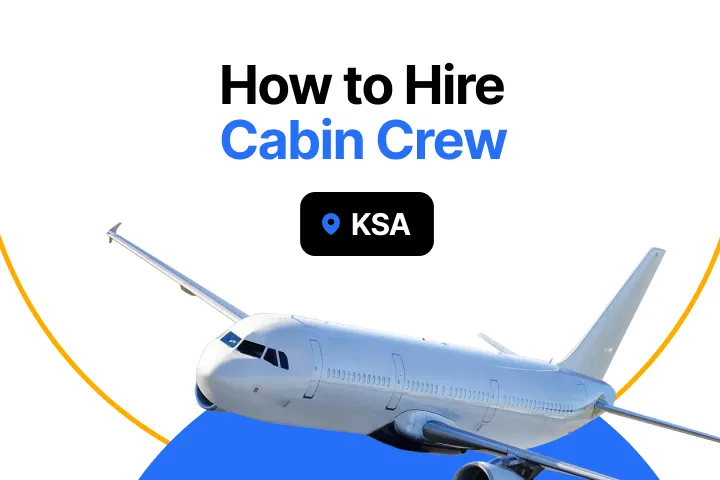يتطلب توظيف الطيران في عمان إدارة الامتثال التفصيلية وعمليات التحقق الصارمة واستراتيجيات التوريد المتخصصة.
تقدم Qureos مجموعة من المواهب التي تم فحصها وجاهزة للطيران تعمل على تبسيط عملية الفحص وتقليل الوقت المستغرق في التوظيف.
يعمل التخطيط المبكر وسير العمل الخاص بالطيران على منع التأخير الموسمي في التوظيف وتحسين الموثوقية التشغيلية.
يتطلب التوظيف في مجال الطيران في عمان مستوى من الدقة والامتثال لا تتطلبه سوى قطاعات أخرى قليلة. ومع توسع شركات الطيران في عملياتها، وتشديد التوقعات التنظيمية، والمواهب المعتمدة ذات العرض المحدود، يجب على مديري التوظيف العمل بنهج منظم خاص بالطيران يضمن السلامة والامتثال والاستمرارية التشغيلية.
لماذا أصبح التوظيف في قطاع الطيران في عمان أكثر صعوبة من أي وقت مضى
أصبح التوظيف في مجال الطيران في عمان معقدًا بشكل متزايد بسبب لوائح هيئة الطيران المدني المتطورة (CAA) وبروتوكولات السلامة المعززة والطلب المتزايد على المهنيين المرخصين.
وفي الوقت نفسه، تستمر المنافسة الإقليمية للطيارين والمهندسين وطاقم الطائرة والمتخصصين الفنيين، مما يشكل ضغطًا إضافيًا على فرق الموارد البشرية لتأمين المواهب المؤهلة بسرعة وثقة.
المقترحة: أفضل منصات التوظيف في عمان
لماذا يختلف التوظيف في مجال الطيران عن التوظيف العام
1. كل دور يؤثر بشكل مباشر على سلامة الركاب
يتحمل متخصصو الطيران، سواء كانوا طيارين أو طاقم الطائرة أو المهندسين - مسؤوليات تؤثر على سلامة الركاب والامتثال التنظيمي. حتى أخطاء التوظيف البسيطة يمكن أن تؤدي إلى اضطرابات تشغيلية ومخاطر تتعلق بالسلامة وإلحاق الضرر بالسمعة.
2. الرقابة التنظيمية الصارمة والتحقق من الترخيص
يجب على مسؤولي التوظيف ضمان الامتثال الكامل لمتطلبات CAA، وفي كثير من الحالات، الأطر الدولية مثل EASA أو FAA.
يتضمن ذلك التحقق من:
- اكتب التقييمات
- اللياقة الطبية
- ساعات الطيران والصيانة المسجلة
- إجادة لغة الإيكاو
- التصاريح الأمنية
غالبًا ما تؤدي هذه الخطوات إلى تمديد الجداول الزمنية للتوظيف، مما يجعل التخطيط المبكر ضروريًا.
3. النمو السريع المقترن بالطلب الموسمي
يتطلب توسيع العمليات في مطار مسقط الدولي وزيادة عدد السياح الوافدين وذروة السفر الموسمية من فرق الطيران زيادة عدد الموظفين بسرعة. نادرًا ما تكون عمليات سير العمل العامة كافية لهذه التقلبات.
المقترحة: الدليل الكامل لقوانين العمل العمانية!
من تقوم بتوظيفه: أدوار الطيران الرئيسية في عمان
الطيارون
يحتاج الطيارون إلى تراخيص ATPL/CPL، وساعات الطيران التي تم التحقق منها، وتقييمات النوع، والشهادة الطبية من الفئة 1، والتحقق من CAA. يتطلب كل دور خبرة محددة في الطائرات، مما يجعل الدقة في القائمة المختصرة أمرًا بالغ الأهمية.
طاقم المقصورة
بالإضافة إلى كفاءات السلامة والخدمة، يجب على طاقم الطائرة تلبية معايير الكفاءة اللغوية والمتطلبات الطبية ومعايير التدريب على الاستجابة للطوارئ.
فرق الصيانة والهندسة
يحتاج مهندسو الطائرات المرخصون (LAE) وفنيو الصيانة إلى شهادات متخصصة وخبرة صيانة معتمدة ومعرفة بأنظمة الجودة والسلامة.
موظفو العمليات الأرضية والدعم
تتطلب هذه الأدوار معرفة تشغيلية قوية وتدريبًا على السلامة والقدرة على العمل في ظل ظروف عالية الضغط وحساسة للوقت.
المقترحة: كيف يتم تأهيل الموظفين في عمان
المهارات الأساسية والشهادات التي يجب أن يمتلكها المرشحون في مجال الطيران
- رخصة ATPL/CPL صالحة (للطيارين)
- اكتب التقييمات المتوافقة مع أسطول صاحب العمل
- مستوى اللغة الإنجليزية 4+ في منظمة الطيران المدني الدولي
- شهادة طبية من الفئة 1 أو الفئة 2
- ساعات الطيران التي تم التحقق منها أو تجربة الصيانة
- التصاريح الأمنية وعمليات التحقق من الخلفية
- الإلمام بقواعد وإجراءات CAA
تظل المهارات اللينة مثل التواصل والعمل الجماعي تحت الضغط وحل النزاعات ضرورية للأدوار الأمامية والتشغيلية.
المقترحة: بناء فرق طيران عالية الأداء
كيفية كتابة الأوصاف الوظيفية الفعالة في مجال الطيران
1. حدد التراخيص والساعات بوضوح
تشمل:
- اكتب التقييمات
- الحد الأدنى من ساعات الطيران أو الصيانة المسجلة
- إجادة اللغة
- الشهادات الطبية
هذا يقلل من التطبيقات غير المؤهلة ويقصر وقت الفحص.
المقترحة: قم بتنزيل قوالب الوصف الوظيفي مجانًا
2. تفاصيل المتطلبات الطبية والأمنية ومتطلبات الامتثال
حدد التوقعات الخاصة بالفحوصات الطبية، وعمليات التحقق من صحة CAA، والجداول الزمنية للتصريح الأمني، والوثائق المطلوبة.
3. تقديم تفاصيل شفافة عن التحول والمسار والتقدم الوظيفي
يقدّر محترفو الطيران الوضوح. حدد:
- جداول دوارة
- توقعات التوقف
- مدة العقد
- مسارات التدريب والترقية
أين يمكن الحصول على مواهب الطيران في عمان
استخدم منصات الطيران المتخصصة
تربط Qureos شركات التوظيف في عمان بمتخصصي الطيران المرخصين الذين تم فحصهم من خلال الفحص القائم على الامتثال. يمكن لمنصات الصناعة مثل JSFirm و Avjobs أن تكمل احتياجات البحث الأوسع.
المقترحة: أدوات الذكاء الاصطناعي في التوظيف في مجال الطيران
كن شريكًا مع أكاديميات الطيران ومراكز التدريب
مؤسسات مثل:
- أكاديمية عمان للطيران
- مراكز التدريب والمحاكاة المحلية
- برامج تدريب رويال فلايت
توفير مجموعات قوية من المواهب في بداية الحياة المهنية والانتقالية.
العمل مع وكالات التوظيف في مجال الطيران
وكالات الطيران المتخصصة يمكن تسريع عملية التوريد وإجراء فحوصات الترخيص ودعم احتياجات التوظيف ذات الحجم الكبير أو العاجلة.
ما يتوقعه مرشحو الطيران في عمان (2025)
التعويض يتماشى مع الشهادات والخبرة
يختلف الدفع حسب:
- مستوى الترخيص
- ساعات الطيران
- اكتب التقييمات
- هيكل خطوط الطيران والمسارات
استخدم نطاقات الرواتب الشفافة لتظل قادرًا على المنافسة.
حزم التعويضات والمزايا
عادةً ما يبحث متخصصو الطيران عن:
- بدلات السكن والنقل
- تذاكر الطيران السنوية
- تأمين طبي
- المنافع العائلية
- دعم إعادة التوطين للمغتربين
الاستبقاء من خلال التطوير المهني
يعد التدريب على أجهزة المحاكاة وترقيات تصنيف النوع وبرامج تطوير القيادة أمرًا ضروريًا للاحتفاظ بموظفي الطيران المهرة في عمان.
الأسئلة الشائعة
أين يمكنني العثور على مواهب الطيران المؤهلة في عمان؟
استخدم منصات مثل Qureos وأكاديميات الطيران ووكالات التوظيف المتخصصة للحصول على مهنيين مرخصين تم فحصهم.
كيف يمكنني التحقق من التراخيص للطيارين والمهندسين؟
قم بتأكيد أوراق الاعتماد مباشرة مع هيئة الطيران المدني، وتحقق من تصنيفات النوع والسجلات الطبية، وراجع الوثائق الأصلية.
ما الذي يجب تضمينه في التوصيف الوظيفي للطيران؟
متطلبات الترخيص، والحد الأدنى من الساعات، وتقييمات النوع، والفحوصات الطبية والأمنية، وتوقعات التحول، والمسارات المهنية.
ما هي المدة التي يستغرقها توظيف شركات الطيران في عمان؟
تستغرق معظم العمليات من 6 إلى 10 أسابيع، اعتمادًا على عمليات التحقق من الخلفية والتصاريح الطبية والجداول الزمنية للتحقق التنظيمي.
لماذا تستخدم منصة توظيف متخصصة مثل Qureos؟
إنه يتيح الفحص المسبق القائم على الامتثال، ويقلل من التطبيقات غير المؤهلة، ويسرع التوظيف للأدوار التي تتطلب الدقة التنظيمية.




